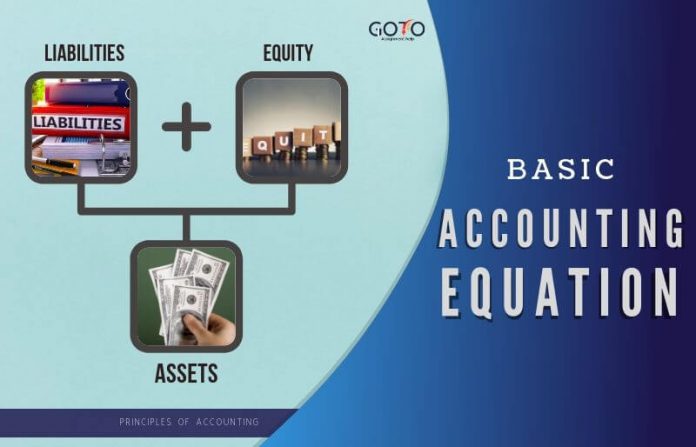An accounting equation is a formula that is used to record the relationship between various financial activities in a business. It is a simplified breakdown of the numbers, and the values entered in the balance sheet of a business or company. The equation defines the correlation between the liabilities, assets, and owners’ equity of a business.
This accounting equation acts as the foundation of the double entry bookkeeping system which implies that all the assets of a company should be equal to the liabilities in the book of accounts. In other words, all the entries made on the debit side of the balance sheet should also have a corresponding entry on the credit side of the balance sheet. It is because of this reason that the basic accounting equation is also referred to as the balance sheet equation.
The basic accounting equation is as follows:
ASSETS = LIABILITIES + EQUITY
What are Assets?
Anything that can be converted into cash is termed as an asset. Individuals and governments also own assets, but for a company, it should generate revenue or bring benefits to the owner. A business primarily owns two types of assets, namely, current and non-current assets.
Those assets that can be transformed into cash in less than a fiscal year or one operating cycle are referred to as current assets. These assets are used for facilitating day-to-day operational expenses like cash, marketable securities, accounts receivable, inventories, etc. On the other hand, non-current assets are also referred to as fixed assets because the company uses these for the production of goods and services having a life of more than one year. Non-current assets of a company can include plant and equipment, property, vehicles, machinery, buildings, land, furniture, etc.
What are Liabilities?
Liability refers to an obligation that a business owes to another entity. It is the total value that a company is expected to pay in the long term and short term. Just like assets, liabilities can also be classified as current and non-current depending upon the context. They include borrowings of a company from bank or individuals, a previous transaction that leads to an unsettled obligation, accounts payable, bonds payable, etc.
What is the Shareholders’ Equity?
Shareholders’ equity refers to the total value of money that has been raised by a company through the issue of shares. Shareholders’ equity is another name that is given to the amount of retained earnings that a company has. Since the shareholders invest some amount of money in a company, they expect to be paid with some dividend which is why it lies on the liabilities side of the company’s accounts book.
As an example, the balance sheet of Amazon.com’s as of year-end 2017 depicted the following scenario:
Liabilities:
As per public records, the current liabilities of Amazon were nearly $57.9 billion, while the long-term debt was $24.7 billion with miscellaneous liabilities of $21 billion. Hence, total liabilities sum up to be $103.6 billion.
Owners’ equity:
As of 2017, the capital surplus was $21.4 billion with retained earnings of $8.6 billion and other equity of ($2.29 billion). This component is negative. Hence the total owners’ equity is $27.72 billion
Now that we have the data for the owners’ equity and liabilities for Amazon, we can figure out the total assets by using the accounting equation. By adding up the liabilities ($103.6 billion) and the owners’ equity ($27.71 billion), we get total assets worth $131.31 billion.
The retained earnings component in the owners’ equity can be broken down into two parts, namely, revenue and expenses. Doing so helps us in understanding the relationship between the balance sheet and income statement of a company in the real world. The business earns revenues for providing products and services to its customers; however, expenses are the costs that are incurred by the business to produce or manufacture it’s offering. If revenues are higher than the costs, then it is referred to as a profitable venture.
The owner of the company can withdraw a salary or equity from the business itself. If the company is incorporated, then the salary could be in the form of a dividend that is paid by the corporation. However, if the company is a small and a sole proprietorship or a limited liability company or a partnership, then the owners can draw their salaries from the business.
Thus, the accounting formula after taking care of sales revenue and expenses can be re-written as follows.
ASSETS = LIABILITIES + OWNERS’ EQUITY + (REVENUE – EXPENSES) – DRAWS
It is crucial to be reminded that if the accounting equation of your business or company does not balance then the financial reports will lose their integrity. As a result of this, it would be difficult for you to keep track of the financial transactions taking place inside and outside the business. Accounting equation serves as a system of checks and balances while ensuring that all the relevant accounts have received their entries and the essence of each transaction is recorded.
What is the Basic Accounting Equation? Explain with Example
There are many students who are confused when they hear the word basic accounting equation and try to find out the difference between accounting equation and basic accounting equation. If you are one of them who wants to know what is basic accounting equation then let me clear your doubt. Basic accounting equation is nothing but another name of accounting equation.
Through the accounting equation a company’s total assets and liabilities are balanced. With accounting equation two words, assets and liabilities are closely related, where assets represent the resource that is controlled by the company and liability represents the obligations that are related to those resources.
If you find any kind of trouble while understanding the basic accounting equation then the below mentioned example will help you to understand it clearly.
Example 1
Let,
- Total Asset is $250 billion
- Total Liabilities is $130 billion
- Total Shareholder’s Equity is $120 billion
Now, if you calculate the value of liability and shareholders’ equity i.e. ($130 billion+ $120 billion) the answer is $250 billion, you will find the exact value of the total assets of the company. So, this is called the basic accounting equation.
Example 2
Below is a portion of XYZ Mobil Corporation balance sheet in millions as of Dec. 31, 2021:
- Total Assets $450,123
- Total liabilities $250,100
- Total equity $200,023
Accounting equation is $250,100 (total liabilities) + $200,023 (total equity) and the result is equal to the total assets.
What Do You Mean by Fundamental Accounting Equation
There are many students to whom the fundamental accounting equation is not clear. As a result they fail to apply the formula in their work. If you are one among them, then let me tell you what the fundamental accounting equation is actually. This is a particular type of equation in which you need to explain the relationship between the assets that are used to form the business and the funds that are used to make purchases. It is also popular for the name balance sheet equation.
Fundamental accounting equation is made up of three variables. These are assets, liabilities and the equity of the owner or shareholders.
The fundamental accounting equation indicates that the total asset of the company must be equal to the sum of the owner’s own fund or the money that the owner has borrowed from different sources. If you are given any two variables then by calculating the amount you can easily get the desired result. Based on it, you can check the profit and loss of the company in a particular time or a financial year. But to get the result, you must have a clear idea about the three variables.
Accounting Equation Formula
Are you searching for an accounting equation formula? Read the paragraph mentioned below, I hope it will clear all your doubts.
Here Assets means Liabilities + Owner’s possession
- To get the accounting equation, the first thing you need to do is enlist all the assets of the company on a balance sheet for a particular period.
- Take a new balance sheet and do a list on the total liabilities of the company
- Now locate the equity of the entire shareholders. Add the number with the total liabilities
- The total asset is equal to the sum of total equity and liability.
Accounting Equation Definition
Accounting equation mainly indicates the total asset of a particular company that is equal to the total sum of its liabilities and its shareholders’ equity too. This is considered to be a straightforward number and when we find this number on the balance sheet of the company then it is called double entry of the accounting system. The main intention of the accounting equation is to maintain balance in the balance sheet so that each debit and credit must remain in a balance.
If you are struggling with accounting fundamentals and having a hard time completing assignments related to the basic accounting equation, then you should seek accounting assignment help from GotoAssignmentHelp. Their team of assignment experts helps you in getting concept clarity while assisting you in completing all your assignments. Their services are available at budget-friendly prices.




 Login
Login 






